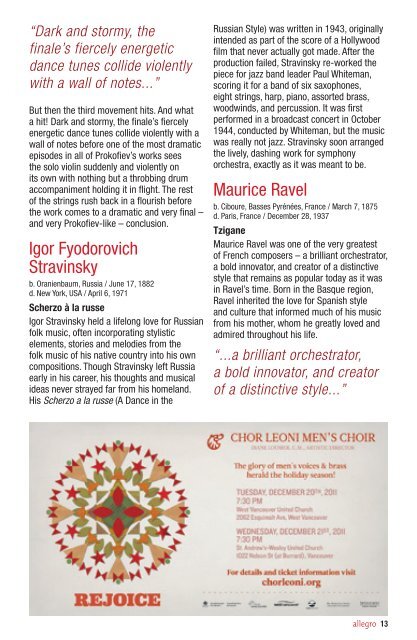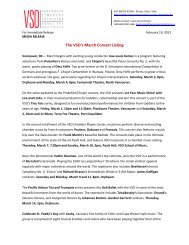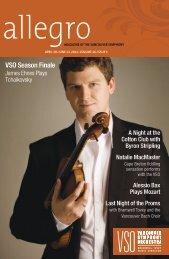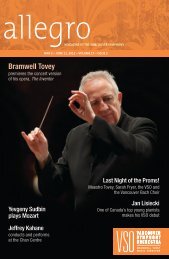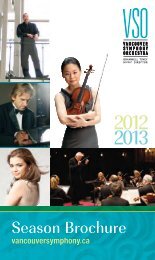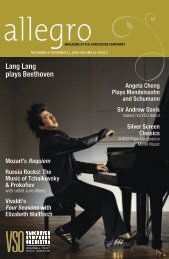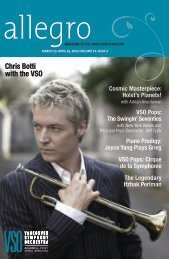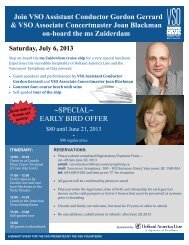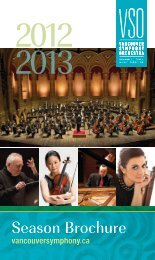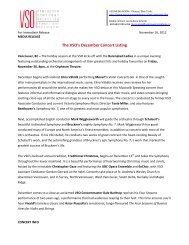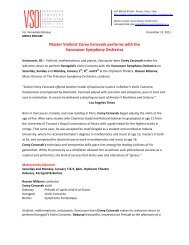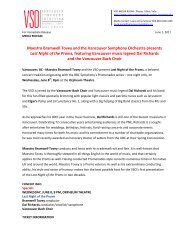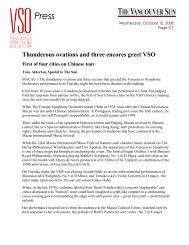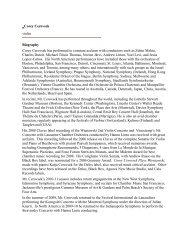issue two - Vancouver Symphony Orchestra
issue two - Vancouver Symphony Orchestra
issue two - Vancouver Symphony Orchestra
Create successful ePaper yourself
Turn your PDF publications into a flip-book with our unique Google optimized e-Paper software.
“Dark and stormy, the<br />
finale’s fiercely energetic<br />
dance tunes collide violently<br />
with a wall of notes...”<br />
But then the third movement hits. And what<br />
a hit! Dark and stormy, the finale’s fiercely<br />
energetic dance tunes collide violently with a<br />
wall of notes before one of the most dramatic<br />
episodes in all of Prokofiev’s works sees<br />
the solo violin suddenly and violently on<br />
its own with nothing but a throbbing drum<br />
accompaniment holding it in flight. The rest<br />
of the strings rush back in a flourish before<br />
the work comes to a dramatic and very final –<br />
and very Prokofiev-like – conclusion.<br />
Igor Fyodorovich<br />
Stravinsky<br />
b. Oranienbaum, Russia / June 17, 1882<br />
d. New York, USA / April 6, 1971<br />
Scherzo à la russe<br />
Igor Stravinsky held a lifelong love for Russian<br />
folk music, often incorporating stylistic<br />
elements, stories and melodies from the<br />
folk music of his native country into his own<br />
compositions. Though Stravinsky left Russia<br />
early in his career, his thoughts and musical<br />
ideas never strayed far from his homeland.<br />
His Scherzo a la russe (A Dance in the<br />
Russian Style) was written in 1943, originally<br />
intended as part of the score of a Hollywood<br />
film that never actually got made. After the<br />
production failed, Stravinsky re-worked the<br />
piece for jazz band leader Paul Whiteman,<br />
scoring it for a band of six saxophones,<br />
eight strings, harp, piano, assorted brass,<br />
woodwinds, and percussion. It was first<br />
performed in a broadcast concert in October<br />
1944, conducted by Whiteman, but the music<br />
was really not jazz. Stravinsky soon arranged<br />
the lively, dashing work for symphony<br />
orchestra, exactly as it was meant to be.<br />
Maurice Ravel<br />
b. Ciboure, Basses Pyrénées, France / March 7, 1875<br />
d. Paris, France / December 28, 1937<br />
Tzigane<br />
Maurice Ravel was one of the very greatest<br />
of French composers – a brilliant orchestrator,<br />
a bold innovator, and creator of a distinctive<br />
style that remains as popular today as it was<br />
in Ravel’s time. Born in the Basque region,<br />
Ravel inherited the love for Spanish style<br />
and culture that informed much of his music<br />
from his mother, whom he greatly loved and<br />
admired throughout his life.<br />
“...a brilliant orchestrator,<br />
a bold innovator, and creator<br />
of a distinctive style...”<br />
allegro 13


